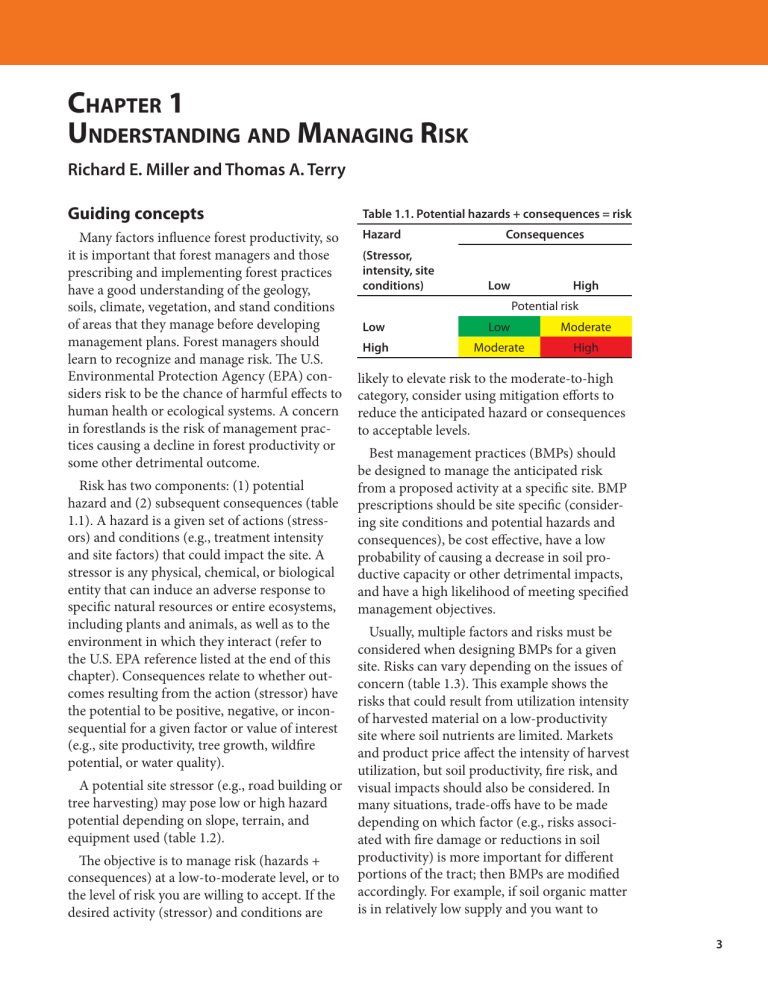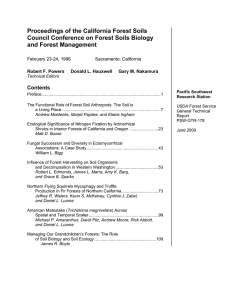c 1 u

c
haPter
1 u
nderstanding and
M
anaging
r
isk
Richard E. Miller and Thomas A. Terry
Guiding concepts
Many factors influence forest productivity, so it is important that forest managers and those prescribing and implementing forest practices have a good understanding of the geology, soils, climate, vegetation, and stand conditions of areas that they manage before developing management plans. Forest managers should learn to recognize and manage risk. The U.S.
Environmental Protection Agency (EPA) considers risk to be the chance of harmful effects to human health or ecological systems. A concern in forestlands is the risk of management practices causing a decline in forest productivity or some other detrimental outcome.
Risk has two components: (1) potential hazard and (2) subsequent consequences (table
1.1). A hazard is a given set of actions (stressors) and conditions (e.g., treatment intensity and site factors) that could impact the site. A stressor is any physical, chemical, or biological entity that can induce an adverse response to specific natural resources or entire ecosystems, including plants and animals, as well as to the environment in which they interact (refer to the U.S. EPA reference listed at the end of this chapter). Consequences relate to whether outcomes resulting from the action (stressor) have the potential to be positive, negative, or inconsequential for a given factor or value of interest
(e.g., site productivity, tree growth, wildfire potential, or water quality).
A potential site stressor (e.g., road building or tree harvesting) may pose low or high hazard potential depending on slope, terrain, and equipment used (table 1.2).
The objective is to manage risk (hazards + consequences) at a low-to-moderate level, or to the level of risk you are willing to accept. If the desired activity (stressor) and conditions are
Table 1.1. Potential hazards + consequences = risk
Hazard Consequences
(Stressor, intensity, site conditions) Low High
Potential risk
Low
High
Low
Moderate
Moderate
High likely to elevate risk to the moderate-to-high category, consider using mitigation efforts to reduce the anticipated hazard or consequences to acceptable levels.
Best management practices (BMPs) should be designed to manage the anticipated risk from a proposed activity at a specific site. BMP prescriptions should be site specific (considering site conditions and potential hazards and consequences), be cost effective, have a low probability of causing a decrease in soil productive capacity or other detrimental impacts, and have a high likelihood of meeting specified management objectives.
Usually, multiple factors and risks must be considered when designing BMPs for a given site. Risks can vary depending on the issues of concern (table 1.3). This example shows the risks that could result from utilization intensity of harvested material on a low-productivity site where soil nutrients are limited. Markets and product price affect the intensity of harvest utilization, but soil productivity, fire risk, and visual impacts should also be considered. In many situations, trade-offs have to be made depending on which factor (e.g., risks associated with fire damage or reductions in soil productivity) is more important for different portions of the tract; then BMPs are modified accordingly. For example, if soil organic matter is in relatively low supply and you want to
3
BEST MANAGEMENT PRACTICES FOR MANAGING SOIL PRODUCTIVITY IN THE DOUGLAS-FIR REGION
Table 1.2. Example of stressor factors and potential hazards and consequences in a forestry management system
Risk =
Low
Potential hazard
High
+ Consequences
Stressor
Road building
Slope
Terrain
Soil drainage
Harvesting
Gentle
Stable
Well-drained
Steep
Unstable
Poorly drained
Erosion
Mass wasting, sediment
Cost, maintenance
Equipment
Utilization
Helicopter
Bole-only
Rubber-tired skidders
Total biomass
Soil compaction
Nutrient removal
Table 1.3. Example of multiple risks and trade-off considerations on a highly nutrientdeficient site where the consequence of removing high levels of biomass has the potential to negatively impact soil quality while reducing wildfire potential
Stressor Factor of concern
(Utilization level) Soil quality Fire
Potential risk
Bole only
Whole tree
All biomass
Low
Moderate
High
High
Moderate
Low minimize the potential for nutrient and water supply limitations over the long term (potential negative consequence), you may want to compromise by increasing biomass utilization levels near homes and roads to reduce fire risk and decreasing utilization (level or intensity) across the remaining tract to maintain soil productivity.
In summary, we suggest five important steps to manage risk:
1. Assess potential hazards and consequences.
2. Consider trade-offs among multiple risks.
3. Mitigate where appropriate to avoid or reduce unacceptable risk.
4. Balance potential risks and costs of mitigation (e.g., why use a helicopter to log gentle slopes with well-drained soils?).
5. Design and implement site-specific
BMPs.
Subsequent chapters in this publication describe many site-based risk factors common to the Douglas-fir region and offer suggestions for developing site-specific BMPs to maintain and enhance soil productivity, avoid mass wasting, and minimize erosion and sedimentation.
Remember to review applicable state forest practice regulations when developing BMPs to make sure that proposed practices meet these requirements as well.
Key references and other resources
United States Environmental Protection Agency. Basic
Information About Risk Assessment. http://epa.gov/ riskassessment/basicinformation.htm#risk .
Washington State Department of Natural Resources.
2009. Forest Practices Illustrated: A Simplified
Guide to Forest Practices Rules in Washington State .
Olympia, WA: Washington State Department of Natural Resources, Forest Practices Division. http://www.dnr.wa.gov/BusinessPermits/Topics/
ForestPracticesRules/Pages/fp_fpi.aspx
.
4


